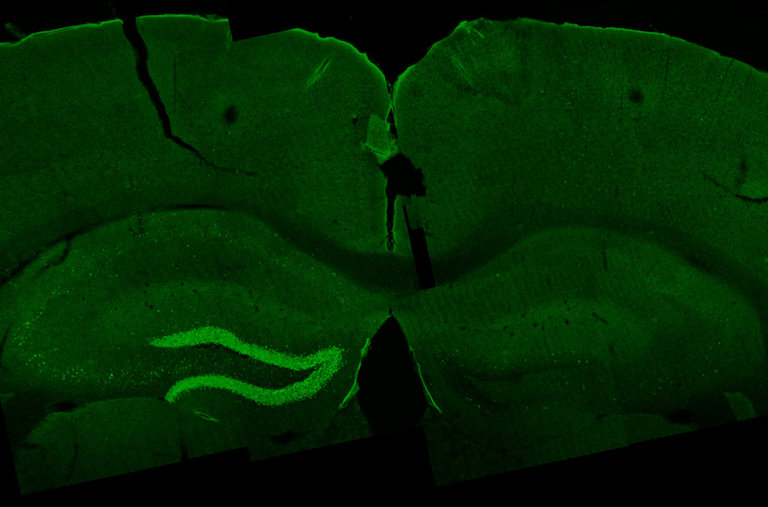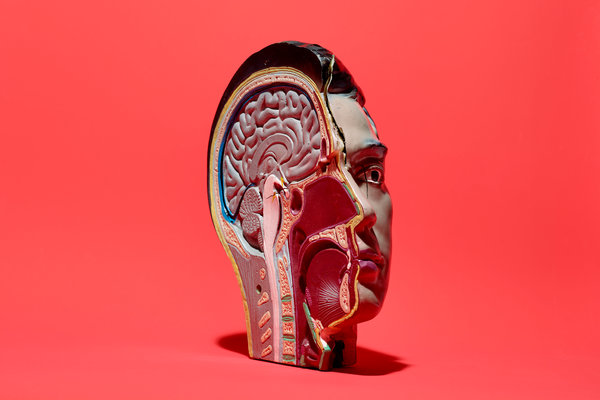A scan of a mouse’s brain showing that some Alzheimer’s-like plaques dissipated after the mouse saw flashing lights and heard clicking sounds. Video by Picower Institute for Learning and Memory, M.I.T.Credit
Could people’s eyes and ears help fix the damage Alzheimer’s disease does to the brain? Just by looking at flashing light and listening to flickering sound?
A new study led by a prominent M.I.T. neuroscientist offers tantalizing promise. It found that when mice engineered to exhibit Alzheimer’s-like qualities were exposed to strobe lights and clicking sounds, important brain functions improved and toxic levels of Alzheimer’s-related proteins diminished.
What’s more, the rapid-fire soundtrack appeared to make mice better at cognitive and memory skills, like navigating mazes and recognizing objects.
[Like the Science Times page on Facebook. | Sign up for the Science Times newsletter.]
Of course, mice are not people. And many drugs that have helped Alzheimer’s-engineered mice haven’t done much for people with Alzheimer’s, which affects 44 million people worldwide, including 5.5 million Americans. Also, because the technique didn’t have long-lasting effects — results faded about a week after the sensory stimulation was stopped — any therapy developed from the research might have to be repeated regularly.
Still, seeing that a noninvasive daily dose of light and sound could have such significant effects in mice give some experts reason for optimism.
“It’s exciting, I think,” said Dr. Lennart Mucke, director of the Gladstone Institute of Neurological Disease, who was not involved in the study. “Reading the paper made me quite enthusiastic about seeing this move forward into some well-crafted clinical trials.”
The experiments were led by Li-Huei Tsai, director of MIT’s Picower Institute for Learning and Memory. She and her colleagues showed that light and sound delivered to mice at a certain frequency — 40 hertz or 40 flashes or clicks per second — appears to synchronize the rhythm of the brain’s gamma waves, which is disrupted in patients with Alzheimer’s. Gamma waves are among several types of electrical brain waves believed to be involved in concentration, sleep, perception and movement.

The experiment setup where flickering light and sound were delivered to Alzheimer’s-engineered mice in the tubs.CreditPicower Institute for Learning and Memory, M.I.T.
Somehow — neither Dr. Tsai nor outside experts are quite sure how — 40 hertz produces a gamma-wave oscillation that appears to increase activation of cells called microglia, which perform trash-clearing and immune-regulating functions. The microglia became more efficient at chewing up the amyloid protein that forms toxic plaques in Alzheimer’s.
Another Alzheimer’s-related protein, tau, which forms tangles, also decreased. And in the sound experiments, brain blood vessels also worked better, further helping clear harmful proteins. Especially striking was that these effects occurred in brain areas active in memory formation, planning and decision-making, and that the mice became better at learning and remembering.
“The effects on cognitive function are pretty big,” said Dr. Walter Koroshetz, director of the National Institute of Neurological Disorders and Stroke, which funds some of Dr. Tsai’s work. He said the results of the study, published Thursday in the journal Cell, are “definitely something that I don’t think anybody could have predicted.”
Enhancing or regulating electrical brain activity through techniques like surgically implanted electrodes is used to treat some other conditions, like Parkinson’s and obsessive-compulsive disorder. And previous research has shown that the activity of gamma waves, the highest-frequency waves ranging from 25 to 140 hertz, decreases in the brains of patients with Alzheimer’s.
Intrigued, Dr. Tsai began experimenting with light, and in 2016, she and colleagues showed, after trying different frequencies, that light flickering at 40 hertz, beamed at mice an hour daily for a week, decreased amyloid and tau and revved up microglia in the brain’s visual cortex.
Aiming to reach other brain areas, she tried sound, settling on clicks because “your brain seems to be able to perceive clicks more than a tone,” she said.
Clicks to improve brain function
An example of the clicking sound that M.I.T. researchers played for mice one hour daily for a week.
Her team found that 40 hertz clicks, broadcast from speakers over mouse enclosures, produced the same brain changes in the auditory cortex and the nearby hippocampus, an area active in forming memories that is damaged early in Alzheimer’s. The mice also performed better at maze navigating and recognizing objects they had seen before.
Light and sound combined magnified the brain effects and extended them to the prefrontal cortex, a key area for planning and executing tasks.
“it’s stunning that the intervention had beneficial effects on so many different aspects of Alzheimer-like pathology,” said Dr. Mucke, who is also a professor of neurology and neuroscience at University of California San Francisco. “On the other hand, it shouldn’t be surprising that the brain is influenced by outside stimuli because what it was designed for was to adapt to a changing environment.”
The results also dovetail with findings by Dr. Mucke and his colleagues, who have genetically altered brain cells called interneurons, which he likened to conductors of the brain’s orchestra. The altered interneurons enhanced gamma rhythm activity, generating cognitive improvement in mice. “When there isn’t proper brain rhythm, there is disharmony and everyone is sort of playing when they want to, a little like the tuning up of an orchestra,” he said.
His colleagues are also developing a drug that would have similar effects. So there might be several ways to enhance gamma rhythms, he said.
Because the brain changes subsided somewhat after a week without the light or sound treatment, experts said it’s likely that people would need such stimulation consistently, essentially a sensory version of a daily pill to control a chronic condition.
Dr. Tsai’s team has tested light and sound on healthy people, using a four-by-three-foot light panel and high-quality stereo speakers, “so the sound is more tolerable to humans, because it’s not melody, it’s clicks,” she said. Electroencephalogram measurements show the desired gamma-wave effect, she said, and “nobody complains about any discomfort or headache or anything.”
They will soon start testing on people with mild Alzheimer’s. Dr. Tsai and a co-author, Edward Boyden, co-director of the M.I.T. Center for Neurobiological Engineering, have also co-founded a company, Cognito Therapeutics, which is testing a goggles-like light-and-sound device on Alzheimer’s patients, she said. Dr. Tsai said the company is not involved in her team’s academic research, which was funded by several foundations and the National Institutes of Health.
Experts cautioned that people should wait for clinical trial results and shouldn’t suddenly start illuminating their homes with disco strobes or pipe clicking sounds through their earbuds.
Still, said Dr. Koroshetz, sensory treatment is likely to be safe for most people.
“Can’t think of any harm that can come out of this one,” he said. And because Alzheimer’s is so devastating, he added: “I think people would participate in studies, even if they require flashing lights for an hour and listening to a very quick drummer.”




